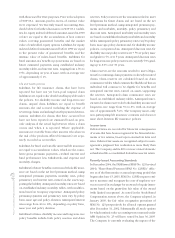American Express 2004 Annual Report Download - page 88
Download and view the complete annual report
Please find page 88 of the 2004 American Express annual report below. You can navigate through the pages in the report by either clicking on the pages listed below, or by using the keyword search tool below to find specific information within the annual report.
Company’s investment portfolio also contains struc-
tured investments of various asset quality, including
CDOs (backed by high-yield bonds and bank loans),
which are not readily marketable. As a result, the car-
rying values of these structured investments are based
on future cash flow projections that require a signifi-
cant degree of management judgment as to the amount
and timing of cash payments, defaults and recovery
rates of the underlying investments and, as such, are
subject to change. Investments also include AEFA’s
investment loans, primarily commercial mortgage
loans, carried at amortized cost, net of reserves for
losses, that consider factors such as underlying collat-
eral values and historical loss experience. Trading
investments are carried at fair value on the balance
sheet with the changes in fair value recorded in results
of operations.
Accounts receivable
Cardmember receivables
Cardmember receivables represent amounts due from
charge card customers and are recorded at the time that
a cardmember enters into a point-of-sale transaction at
a service establishment. Cardmember receivable bal-
ances are presented on the balance sheet net of reserves
for losses, which are discussed below, and typically
include principal and any related fees.
Reserves for losses — cardmember receivables
The Company’s reserves for losses relating to cardmem-
ber receivables represent management’s estimate of the
amount necessary to absorb losses inherent in the Com-
pany’s outstanding portfolio of receivables. Manage-
ment’s evaluation process requires certain estimates and
judgments. Reserves for these losses are primarily based
upon models that analyze specific portfolio statistics and
also reflect, to a lesser extent, management’s judgment
regarding overall adequacy. The analytic models take
into account several factors, including average write-off
rates for various stages of receivable aging (i.e., current,
30 days, 60 days, 90 days) over a 24-month period and
average bankruptcy and recovery rates. In exercising its
judgment to adjust reserves that are calculated by the ana-
lytic model, management considers the level of coverage
of past-due accounts, as well as external indicators, such
as leading economic indicators, unemployment rate, con-
sumer confidence index, purchasing manager’s index,
bankruptcy filings and the regulatory environment. Card-
member receivable balances are written-off when man-
agement deems amounts to be uncollectible, which is
generally determined by the number of days past due. In
general, bankruptcy and deceased accounts are written-
off upon notification, while other accounts are written-off
when 360 days past due. To the extent historical credit
experience is not indicative of future performance or
other assumptions used by management do not prevail,
loss experience could differ significantly, resulting in
either higher or lower future provisions for losses, as
applicable.
Loans
Cardmember lending
Cardmember loans at TRS represent amounts due from
customers of the Company’s lending products, and are
recorded at the time that a cardmember enters into a
point-of-sale transaction at a service establishment.
These loans are presented on the balance sheet net of
reserves for cardmember losses, which are explained
further below, and include accrued interest receivable
and fees as of the balance sheet date. Additionally,
cardmember loans include balances with extended
payment terms on certain charge card products, such
as Sign and Travel and Extended Payment Option. The
Company’s policy is to cease accruing for interest
receivable once a related cardmember loan is greater
than 180 days past due.
Reserve for losses — cardmember lending
The Company’s reserves for losses relating to cardmem-
ber loans represent management’s estimate of the
amount necessary to absorb losses inherent in the Com-
pany’s outstanding loan portfolio. Management’s evalu-
ation process requires certain estimates and judgments.
Reserves for these losses are primarily based upon mod-
els that analyze specific portfolio statistics and also reflect,
to a lesser extent, management’s judgment regarding
overall adequacy. The analytic models take into account
several factors, including average write-off rates for vari-
ous stages of receivable aging (i.e., current, 30 days, 60
days, 90 days) over a 24-month period and average bank-
ruptcy and recovery rates. In exercising its judgment to
adjust reserves that are calculated by the analytic model,
management considers the level of coverage of past-due
accounts, as well as external indicators, such as leading
economic indicators, unemployment rate, consumer con-
fidence index, purchasing manager’s index, bankruptcy
filings and the regulatory environment.
Cardmember loans are written-off when management
deems amounts to be uncollectible, which is generally
determined by the number of days past due. In general,
bankruptcy and deceased accounts are written-off upon
notification, while other accounts are written-off when
180 days past due. To the extent historical credit experi-
ence is not indicative of future performance or other
AXP
AR.04
86
Notes to Consolidated Financial Statements
























